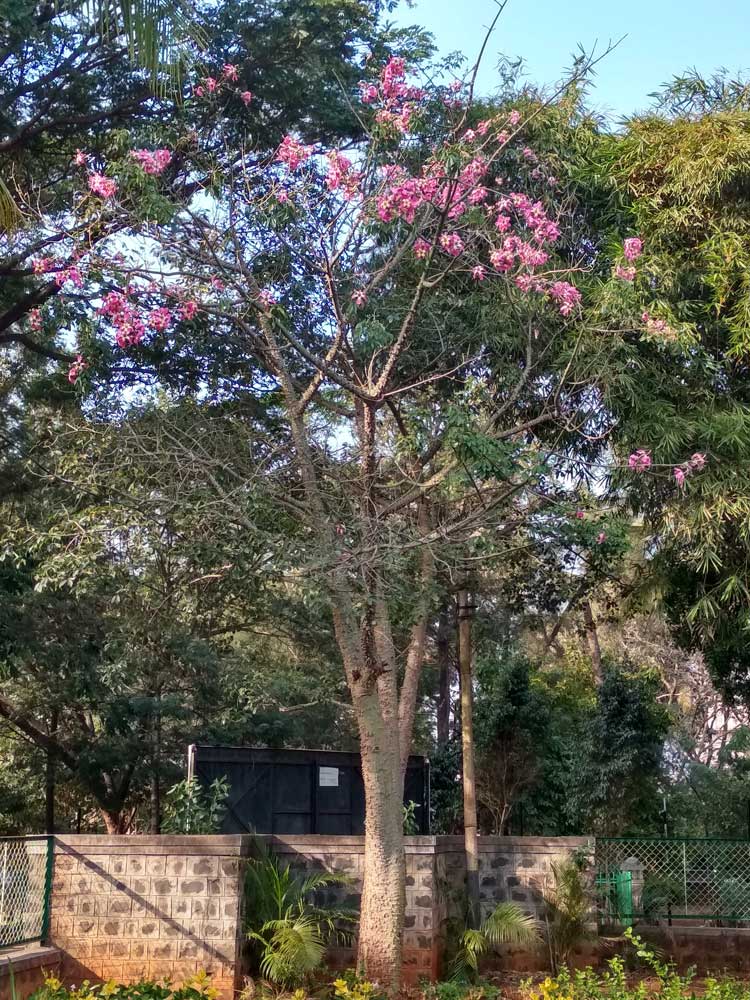Resham rui - Floss Silk Tree

Ceiba speciosa
Summary
Scientific Classification
Kingdom: Plantae
Division: Magnoliophyta
Class: Magnolipsida
Order: Malvales
Family: Malvaceae
Genus: Ceiba
Species: C.speciosa
Scientific Name: Ceiba speciosa(A.St.-Hil.) Ravenna.
Common names
English : Silk floss tree, Kapok, Floss silk tree ,Kapok, Floss silk tree, Palo borracho, Kurayjia.
Hindi: Resham rui.
Discription
- Habit and Habitat: Genus Ceiba is from a vernacular South American name for the silk-cotton tree. Species speciosa means showy and handsome Conical-shaped tree, able to grow up to about 9 - 18 m tall.Floss Silk Tree is often rated among the most beautiful trees in the world. Also called Silk Floss Tree, this deciduous tropical from Brazil and Argentina is a large tree rated to over 40 feet. Floss Silk Tree is also well known for the large spikes protecting the trunk and limbs.
- Distribution: it is a species of deciduous tree native to the tropical and subtropical forests of South America.This plant is native to the Amazon Rainforest in South America, more specifically, in the north-east region of Argentina, Eastern Bolivia, Paraguay, and Uruguay. The Silk Floss Tree was brought up to the United States and many other countries to be planted for decorative purposes.
- Morphology:
Leaf: : Light green leaves, palmately divided into 5 - 7 lanceolate leaflets measuring 12 cm long and with serrate margins, leaves are usually shed before the flowering period starts.
Inflorescence: Cymose.
Flowers: Flowers: Showy pink 5-petaled funnel-shaped flowers with yellowish-white throats, each flower about 10 - 15 cm long.,Flower-pedicellate, pedicel small, 12 cm long, green, regular, bisexual, actinomorphic, hypogynous, showy, appearing when the tree is leafless; Sepals- 5, gamosepalous, half green and half reddish, valvate, cup shaped, inferior; Petals – 5, polypetalous, yellowish base with pinkish ends, rippled edges with ivory throat, flecked with brown, dark purplish longitudinal patches on the base, hairy outer surface.
Androecium: anthers yellow, longitudinal dehiscence, versatile, five staminodes basal, blakish top with creamish filaments, hairy ends Stamens many, fusion of filaments to form tube, reddish colored, ten anthers at the end of the tube, anthers yellow, lonfitudinal dehiscence, versatiles.
Gynoecium: inferior; Crapels – 2, connate in a superior 25 loculed ovary, ovary swollen, with 2-many anatropous ovules in each locule, axile placentation, stigma simple, style- 1, creamish, thin, tubular; Fruit- Ovoid, large capsule, green at first, grey-brown after ripening, round, hard, 6-12 inch, many seeds, pod splits open to reveal silky fibres like the semal’s, when fully open- away in a strong wind, helping to disperse the seeds.
Fruit: Fruits: Fruit is a dehiscent pear-shaped to oblong pod about 20 cm long, inside contains white cotton-like matter with black seeds.
Seeds: Small, brown, thin.
Flowering and Fruiting time: Spring ,C. speciosa flowers are in bloom between February and May (in its native Southern Hemisphere), but can also bloom at other times of the year. - Propagation: Through seeds.
-
Importance:
a. The wood can be used to make canoes, as wood pulp, and to make paper.
b. The bark has been used to make ropes. From the seeds it is possible to obtain vegetable oil.
c. It is cultivated as a flowering specimen tree and for ornamental purposes.
d. The seedpod silk has been used to stuff cushions.
e. From the seeds it is possible to obtain vegetable oil (both edible and industrially useful). - Location: Anant Manohar Garden.
 Trees of GSS Project supported by Makerspace Belgaum Website concept and designe by
Trees of GSS Project supported by Makerspace Belgaum Website concept and designe by